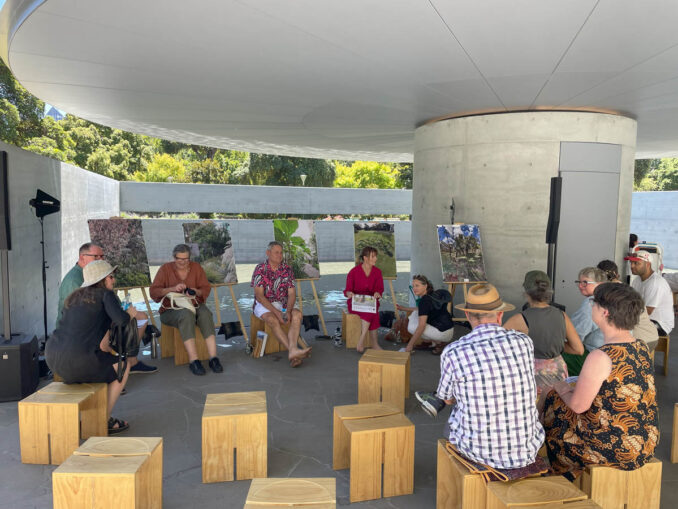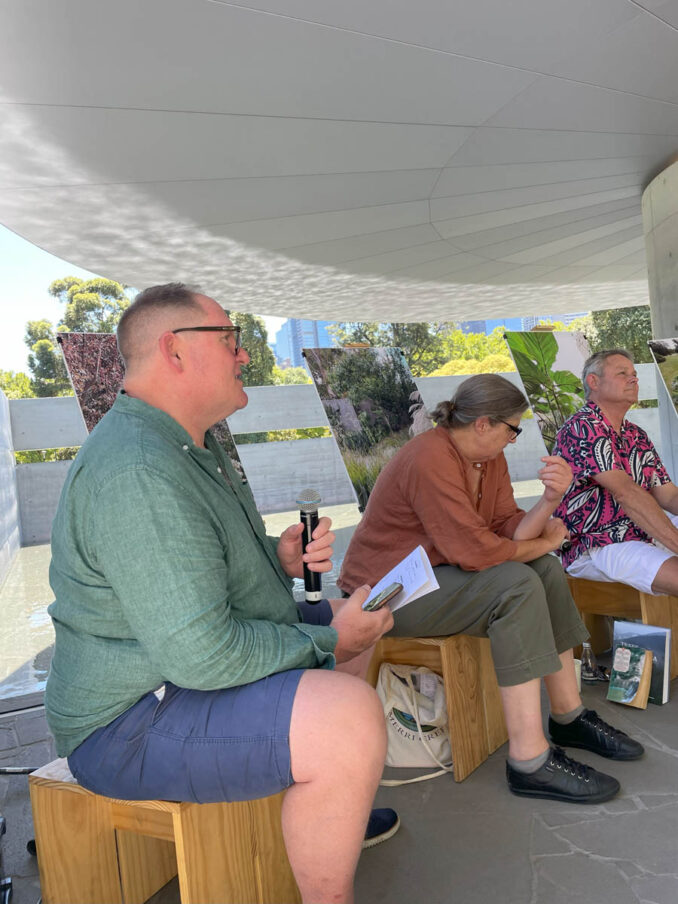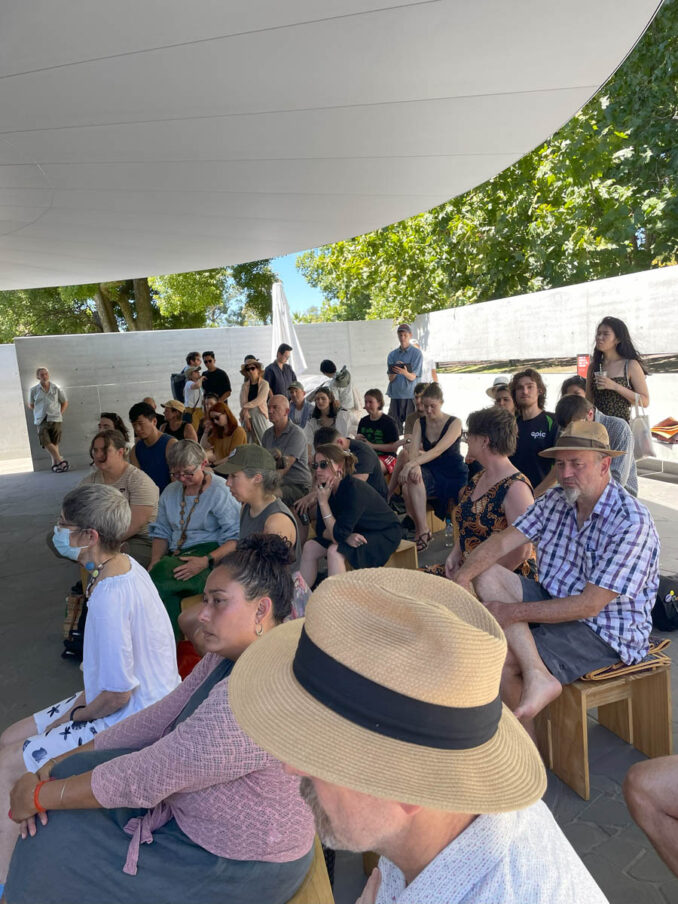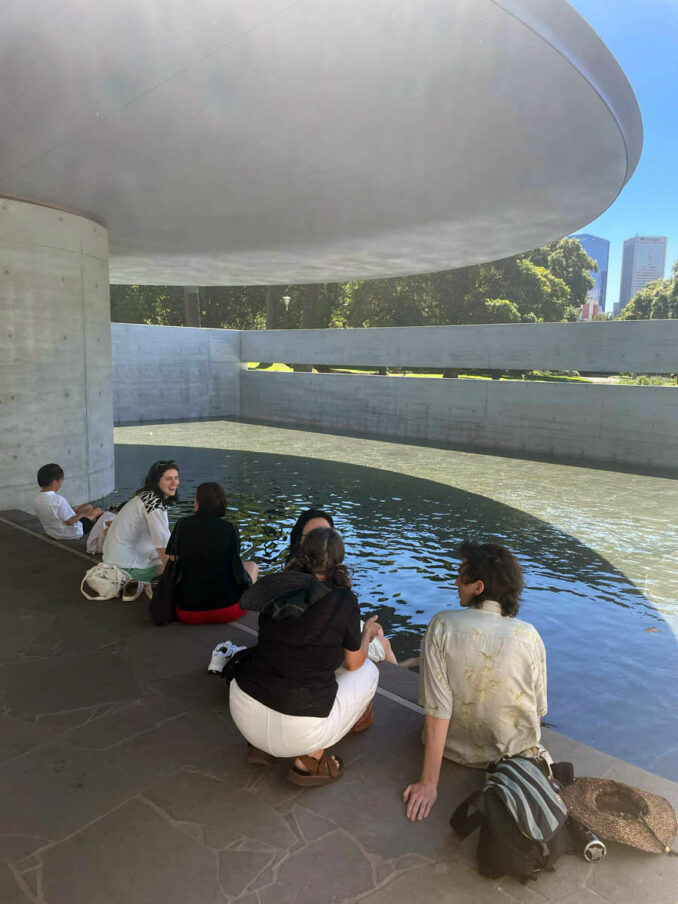Plants, Growth, Creativity And Care was held as part of the 2024 program at the MPavilion in Melbourne, Australia. The event’s premise was for a group of gardeners with different backgrounds and contexts to discuss plants and care in relationship with their gardens and gardening practices.

The gardeners included the organiser Julian Raxworthy, Associate Professor and Discipline Lead: landscape architecture at the University of Canberra; Fiona Harrisson, a landscape architect, Senior Lecturer at RMIT University; Joanne Mott, an interdisciplinary artist; Amanda Oliver, a horticulturist and landscape designer; and Michael Wright, a gardener, and partner at rush\wright associates;

The themes addressed were based on Julian’s book Overgrown: Practices between Landscape Architecture and Gardening (read the review here). Each gardener (presenter) started the event by discussing their relationship with plants using an image on the stage as a starting point. Most of the presenters discussed their relationships through stories of either childhood memories, a design project, or an art installation. What becomes evident during the presentation and following discussions is that many people relate to plants and nature through stories or narratives of (personal) history or experiences. Also, Plants have a history, whether it be how they were imported or cultivated and how people have, due to preference, changed the landscape through plant selection. These selections have significantly impacted our natural landscape, built environments, and the landscape industry (design and nurseries) over time. Trees and plants that were once commonplace are now hard to find, with many plants disappearing not due to environmental reasons (such as becoming weeds) but more due to the preferences of gardeners, landscape architects, and governments. At the same time, other plants have become more readily available due to gardening and landscape design trends.
Plants, Growth, Creativity And Care also addressed how plants can symbolise a time or period in history, such as during the Federation of Australia when only plants from the (British) Empire could be used in a school initiative to create maps of Australia[1] or the selection of a Ficus dammaropsis for the Terrace Courtyard at the Shrine in Melbourne to represent the campaigns in New Guinea[2].

The gardeners also discussed plants on Country* and how they can influence our relationship with the land. Plants and place are intertwined, and we have come to understand that some plants cannot be cultivated, so they can only exist in that place and thus have greater importance and introspection about our relationship to Country.
Discussing the concept of care compared to maintenance provided insights into how we need to care for rather than maintain landscapes and that they are often seen as static rather than dynamic. Care of landscape considers the season, flowering period, and working with natural form rather than clipping to an aesthetic form (ball or similar) or trying to reduce risk. Often, the difference between care and maintenance is down to the longevity of staff and their understanding of the design or intent.
The presenters reflected on the push to design a public landscape for no maintenance, which in some way is reflected in local government plant palettes, but the question remains: is that the quality of landscape we wish to see? This led to a more significant discussion about the lack of skills in the trade and the reduction in rigor in teaching horticulture at technical schools, dramatically impacting public landscapes along with the push to low maintenance (a.k.a. blow and go in the USA).
The presentation and Q&A were a timely discussion about the role of plants, maintenance, and horticulture in many ways, reminding us that design and planting are not finished when the final certificate is signed and the handover is finished. My final realisation was the need for greater involvement of landscape architects in horticulture, including nurseries and maintenance.
Plants, Growth, Creativity, And Care was held on February 3, 2024, at the Tadao Ando designed MPavilion in the Queen Victoria Gardens, Melbourne, Australia.

Article by Damian Holmes, Founder & Editor of World Landscape Architecture [WLA]. Images and Text credit: Damian Holmes.
*Country – Country is a term used by First Nations peoples [of Australia] to refer to the lands, waters, and skies to which they are connected through ancestral ties and family origins.
What Is Country? | Common Ground, Gemma Pol, 5 July 2021, www.commonground.org.au/article/what-is-country. (Accessed: 11 February 2024).
[1] Joanne Mott, 3 February, 2024.
[2] Michael Wright; 3 February, 2024.
